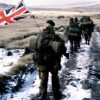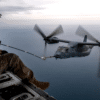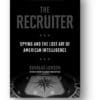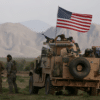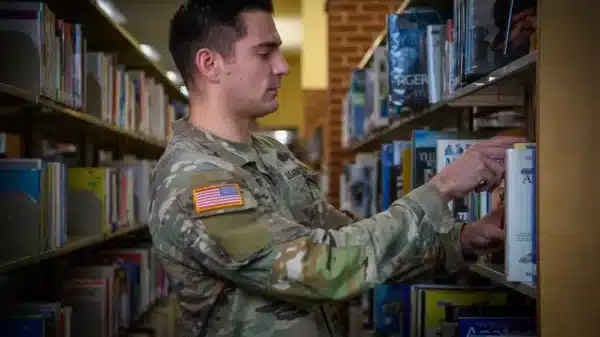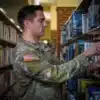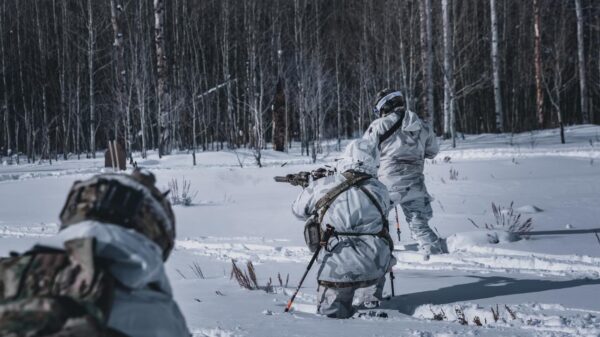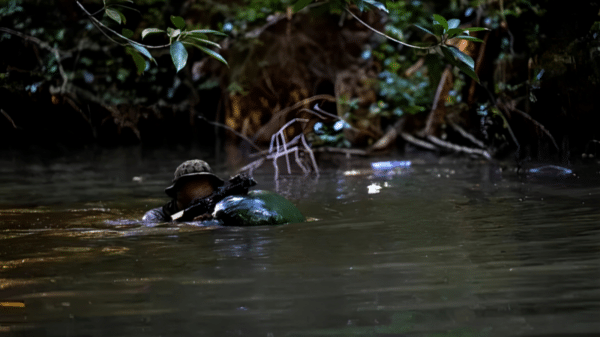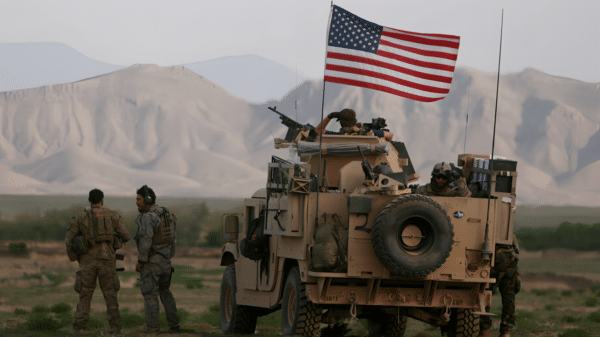Matthew Miller, U.S. Special Operations Command, Tampa. FL, USA
ABSTRACT
As we passed the 40th anniversary of the Falklands War, this conflict still offers valuable insights for the special operations community as an applied historical case study. The British Special Forces conducted special operations missions at great distance from the United Kingdom, against a capable enemy under tremendously difficult environmental conditions. If the Falklands conflict is examined as an example of a strategic node in global competition, or conflict, it offers numerous insights for the requirements and utility of 21st century Special Operation Forces.
On 2 April 1982, Argentina’s military, led by General Mario Menendez, invaded the Falkland Islands, a British overseas territory in the south Atlantic, known for its difficult terrain and “weather characterized by blowing snow, constant drizzle, squalls of freezing rain, and gusting wind.”[1] The Argentinean military deployed forces 300 miles across the south Atlantic to conduct an amphibious landing on both the Falkland Islands and South Georgia. After light resistance from the small detachment of British Royal Marines, the Argentines had firm control of the islands and immediately set upon the militarization of airfields, ports, and building fortifications around urban areas. The Argentinians would hold the island for 72 days.
On 5 April, the British Special Forces, the 22nd Special Air Service (SAS) Regiment and Special Boat Squadron (SBS) deployed for Operation Corporate, with the greater British naval task force to conduct special operations missions across the islands and potentially inside Argentina.[2] The British military knew surprisingly little about the Falklands and South Georgia Islands and the majority of the soldiers who deployed could not find the Falklands on a map. The British conventional military, as part of North Atlantic Treaty Organization (NATO), had been focused on a looming Cold War battle with the Warsaw Pact in West Germany’s Fulda Gap. Despite this, the SAS and SBS had both participated in several military actions over the previous decades, often far from the British Isles and NATO. In the early days of the Falklands War, the Ministry of Defence called on British Special Forces to provide the much-needed tactical intelligence experience and to conduct direct action in support of the British amphibious landings.[3]
To support the recapture of the South Atlantic dependencies, D and G Squadrons SAS of approximately 128 soldiers, along with 84 members of SBS, embarked with the Naval Task Force. An additional troopfrom B Squadron joined the task force after the loss of 18 men in a helicopter crash on 19 May.[4] The SAS’ primary initial role was strategic reconnaissance against Argentine troop strengths and locations, as well as key aspects of the defense; airlift and close air support capability, ammunition and fuel sites, and the location of Argentine special forces. The SBS would focus on the amphibious reconnaissance of potential beach landing sites and coastal defenses to provide the Naval Task Force the best opportunity for a successful amphibious landing.[5] As intelligence collected by the SAS and SBS informed the British strategy, both organizations were prepared to conduct direct action and guerrilla warfare in support of the expeditionary landing force.
Operation Paraquet
The British Naval Task Force’s first mission was the recapture the South Georgia Islands 810 miles east of the Falkland Islands, and 7,800 miles from the United Kingdom. Operation Paraquet was conducted by a Naval Task Force which consisted of the destroyer HMS Antrim, the frigate HMS Plymouth, the fleet oiler Tidespring, and the frigate HMS Brilliant joined later. The amphibious landing force consisted of M Company, 42 Commando Royal Marines, 19 (Mountain) Troop, D Squadron SAS, and 2 detachments of SBS which were embarked on the submarine HMS Conqueror. The Argentinian garrison consisted of 133 Marines and 57 civilians who were on the islands to salvage scrap metal from abandoned whaling stations.
Operation Paraquet was planned to be carried out in three phases. First, the SAS would conduct a helicopter insertion onto Fortuna Glacier from where they would perform reconnaissance of outpost Leith, Husvik, and Stromness. Second, the SBS would be inserted by helicopter into the area of Hounds Bay to assess the avenues of approach for the assault on Argentinian garrison at Grytviken. After the completion of the SAS and SBS reconnaissance, the 42 Commando Royal Marines would land and coordinate an assault on the Argentine forces at Grytviken securing the island.
The SAS decision was made to insert onto Fortuna Glacier despite disagreement among the planners due to the difficulty in terrain.[6] The insertion was complicated by the onset of a south Atlantic storm, which threatened the task force at sea, and turned the reconnaissance mission into a survival situation. After the first night on the glacier, 19 Troop called for an extraction, however in the extreme weather, two of the three Wessex helicopters crashed in a whiteout. The third Wessex, equipped with radar and a new computerized flight control system, made it as it was better suited to navigate the weather and mountainous terrain.[7] The third upgraded Wessex was able to pick up the SAS and the two downed flight crews and return the entire force to the Antrim safely, but the reconnaissance mission would have to be rethought.
With the loss of two Wessex helicopters, the SAS opted to conduct its infiltration by sea in five Gemini inflatable boats. The combination of unreliable motors, and an icy sea, resulted in only three Geminis arriving at the landing site. Two boats were adrift at night in high seas. One of the Geminis ran ashore up the coast and the last Gemini crew was rescued, 60 miles out to sea by the same advanced Wessex helicopter that pulled them off the glacier a few days earlier. The SBS reconnaissance mission ran into its own environmental challenges. The SBS’s efforts to infiltrate by water via Cumberland Bay were hampered by a larger calve of Nordenskjold glacier which created innumerable icebergs that made the bay impassable to small boats.[8]
On 25 April, the task force helicopters, cued by intelligence reports, sighted the Argentine submarine Santa Fe leaving the harbor at Grytviken to confront the British ships around South Georgia. The submarine attempted to return to the safety of the harbor only to be disabled by helicopters with depth charges, torpedoes, and machine guns. This alerted the Argentines to the British task force’s presence, but it also left the small defensive force in Grytviken without their only means of challenging the British Naval Task Force at sea.
With the loss of surprise and the Royal Marines still at sea, the SAS and task force leadership launched a joint force which included the advanced party of Royal Marines, D Squadron SAS, and SBS by helicopter to assault the Argentine garrisons on South Georgia. The ad hoc assault force confronted the Argentines with the British destroyer Antrim’s guns in plain view offshore. Without a fight, the commander of the Argentine forces at Grytviken surrendered on 25 April. The last small garrison at Leith, despite vowing to fight to the death after the fall of Grytviken, surrendered the next day.
The British task force hobbled together for the 7,800-mile journey to South Georgia and managed to recapture the islands without any prior intelligence about enemy forces. South Georgia’s geography, terrain, and weather had put both the Argentines and British at the limits of their military capabilities, but also demonstrated the ability of the SAS to adapt after failures and near catastrophe, to seize the initiative when it presented itself at Grytviken. Operation Paraquet, as the first special operations mission of the Falklands, reinforced the need for modern SOF maritime and aviation platforms capable of supporting the unique mission requirements of British Special Forces.
South Georgia, a small inhospitable island, with no permanent residents, was strategic in the battle for the Falklands. For Argentina, it had always been synonymous with its claim to the Falkland Islands, despite having never occupied the islands. For the British, the island’s recapture was an enormous strategic political victory for the United Kingdom, which helped maintain public support for the Prime Minister Margert Thatcher’s decision to use military force.
Operation Prelim
With the British Naval Task Force in route, the Argentinians established a forward base at the small airfield on Pebble Island, north of West Falkland Island. The Pebble Island airfield’s Pucara ground-attack aircraft was within range of Foul Bay and the Falkland Sound, both of which contained potential landing sites for the British task forces. This obvious threat to the British landing and potential beachhead had to be addressed. An initial plan to bombard the garrison with aircraft and naval gunfire was ruled out due to the risk of civilian casualties and damage to property, but since the airfield could not be bypassed, D Squadron, SAS was given task of conducting a raid to destroy any attack aircraft on the airfield.
On 11 May, 17 (Boat) Troop, D squadron, was inserted by helicopter and canoe, and over the next four days managed to establish surveillance positions around the airfield determining troop strengths, disposition, and security procedures. Additionally, they discovered the airfield was being used for C-130 resupply missions from mainland Argentina to troops throughout the Falkland Islands.[9] With the need to protect the landings and the opportunity to disrupt Argentina’s logistics flow to the islands, the order was given for the deployment of the remainder of D Squadron to conduct a raid on the airfield.
The British Navy’s helicopters, equipped with new night vision goggles, flew in near hurricane force winds to insert D Squadron on Pebble Island.[10] With 17 Troop already in place to serve as guides, D Squadron would deploy 18 (Mobility) Troop as the raid force for the airfield, 16 (Air) Troop would screen off the settlement, and 19 Troop would serve as the reserve.[11] The darkness, distance, terrain, and bitter cold slowed the movement, and with 18 Troop late to arrive on the airfield, 19 Troop was given the primary task of destroying the Pucara aircraft.[12]
The SAS had a hard exfiltration deadline of 0730 due to the threat to the carrier HMS Hermes, which had to come in close to Peddle Island to launch and recover the helicopters. Without alerting the Argentines, 19 Troop affixed demolition charges onto the aircraft in a way that parts could not be recovered from one damaged aircraft, to put another damaged aircraft back into service.[13] Once the charges were set, the squadron engaged the airfield with machine guns, 40mm grenades, and LAW rockets. The destroyer, HMS Glamorgan, provided naval gunfire which largely kept the Argentine forces at bay while the SAS completed the assault on the airfield’s infrastructure. The Glamorgan support was limited by nautical twilight, due to Argentinian air force, which had sunk the HMS Sheffield a week earlier.
The SAS’ ability to execute a short-notice clandestine insertion, and use speed and surprise to destroy eleven aircraft, was reminiscent of the SAS’ earliest missions in North Africa during World War II. D Squadron, SAS, with three injured, met the helicopters on time, and were successfully returned to the HMS Hermes. The mission resulted in the destruction of six Pucara, four Beechcraft T-34 Mentor reconnaissance aircraft, a skyvan cargo plane, as well as the ammunition and fuel dumps on the airfield.[14] Although the Argentinians were able to bring four replacement Pucara from Argentina the next day, the SAS raid on Pebble Island, and the SBS airstrikes on the Argentine helicopter squadron six days later, had a significant impact on General Menendez’s ability to prevent the establishment of a British beachhead.
Strategic Reconnaissance
The near total lack of intelligence on the strength, disposition, and location of Argentine military forces across the Falkland Islands, called for an extensive SAS and SBS ground reconnaissance mission. Ground and amphibious reconnaissance held the best hope to identify Argentine forces and key centres of gravity to allow for a swift recapture of the islands. The longer British forces were at sea, the greater the risk of the Argentine Air Force and its Exocet missiles crippling the landing force before it could be put ashore. To collect this time sensitive intelligence, eight patrols of G Squadron SAS and two from the SBS began insertions and patrols across the East and West Falkland Islands on 30 April.[15]
The reconnaissance patrols moved at night and quickly began to map the 30,000 Argentine troops on the Falklands, most of which had garrisoned in and around the major population centres on the islands. Suspecting the British were on the islands, Argentine troops conducted numerous patrols and employed signal intelligence techniques to locate the small reconnaissance team.[16] The SAS and SBS managed to avoid detection through traditional reconnaissance skills to include night movements, camouflage, and communication discipline.
Across the eastern Falkland Island, which held most population centres and Argentine troops, the SBS conducted traditional amphibious reconnaissance to provide hydrographic surveys and enemy troop locations of potential landing sites to include San Carlos, Port San Carlos, and Ajax Bay. The task force leadership would choose San Carlos as the site of its amphibious landing. On the West Falkland Islands, the three SBS reconnaissance teams successfully located, tracked, and harassed an Argentine force estimated at over 1000 troops, which prevented any movement to counter the British landing across the narrow Falkland Sounds at San Carlos.[17]
The Argentine commander, Major General Mario Menendez, planned for an air mobile defense of the islands and to challenge the British on the beach. Although his troops were garrisoned in central population centres, his helicopter force moved nightly to avoid detection. Once the British landing site was identified, an air assault would be conducted with 15 helicopters delivering troops to the beachhead to repulse the British landing force. The air assault would be covered by air support from the mainland and Pucara light attack aircraft from Peddle Island.
On 20 May, one of the SAS teams located a portion of the helicopter force and called in an airstrike from carrier-based Sea Harriers. The attack resulted in the destruction of Argentina’s only two heavy lift Chinooks, and two of the six medium lift Puma helicopters. This loss of lift capability, compounded by maintenance and weather, would limit Menendez’s ability to move the bulk of his troops from Port Stanley to challenge the landing at San Carlos.[18] However, the fight for the Falklands was far from a one-sided affair. Four days later, the Argentine’s sank the British cargo ship SS Atlantic Conveyor with two French Exocet cruise missiles. The ship had been carrying the bulk of the British heavy lift helicopters and resulted in the loss of 6 Wessexs, 3 Chinooks, and 1 Lynx, which in turn limited British mobility on islands.
With limited airlift, the Argentine forces were left to confront the British on the beach with units that had already been forward deployed. The 62 man “Eagle Detachment,” was deployed forward to conduct reconnaissance and harass any landing force until Menendez’s air assault could arrive to push the British back into the sea.[19] On 21 May, the SBS reconnaissance teams located the Eagle Detachment dug in at Fanning Head north of San Carlos. The Argentines were armed with an assort of small arms to include 105mm wheeled recoilless anti-tank guns, which could be used from shore against British landing craft as they approached the beach.[20]
The small SBS reconnaissance team—equipped with the advantage of night vision and thermal imaging—mapped Argentine positions and, reinforced by an additional 20 members of 3 SBS, launched an assault on Fanning Head. Naval gunfire from HMS Antrim, and direct fire from the SBS with machine guns and LAW rockets delivered a heavy toll. By the time the SBS had closed with Argentine positions, the majority of the Eagle Detachment had fled leaving 11 dead and 3 wounded.[21] Although displaced and no longer a threat to the landing, the Eagle Detachment would bring down two British Wessex helicopters with surface-to-air missiles in later engagements.[22]
The strategic and amphibious reconnaissance conducted on the East and West Falkland Islands by small SAS and SBS provided naval and ground task force commanders with key intelligence on the force strengths, locations, and general poor disposition of Argentine force across the islands. The British task force, which had sailed from the United Kingdom without any practical intelligence, used these small unit traditional reconnaissance missions to map the Argentine forces, target its key defense, and choose the best site for its amphibious landing.
Deception at Darwin
On 19 May, days after the Pebble Island raid, the threat to capitol ships was considered so great, the Hermes was to be kept farther out to sea. As a result, the SAS would be administratively relocated to other ships of the amphibious landing force. It was during this movement that a Sea King helicopter crashed either due to mechanical failure or bird strikes, while attempting to land on the HMS Intrepid. The crash killed 22 Service members, to include D and G Squadron SAS, both squadron sergeant majors.[23] This was the largest loss of life in the SAS since World War II and would require the reinforcement from B Squadron SAS already in route to the Falklands theater.[24]
The day after the helicopter crash, D Squadron was tasked with conducting a diversionary raid against the Argentine garrison at Darwin to support the amphibious task force landing. D Squadron flew by helicopter into Darwin/Goose Green areas at night and successfully moved to the Darwin garrison undetected. As the amphibious task force prepared to land the bulk of the invasion force 20 miles north at San Carlos, D Squadron launched a diversionary assault with machine guns, mortars, LAW rockets, and naval gunfire against the Darwin garrison. The surprise and intensity of the fire resulted in the leadership of the garrison reporting to the Argentine headquarters in Port Stanley that the British landing was at Darwin.
The mission was to divert as many Argentine troops as possible from the amphibious landing at San Carlos. In practical terms, the mission was a success. General Menendez’s headquarters believed Darwin was the primary landing site, which confirmed his assumptions that San Carlos’ terrain was too difficult for an amphibious landing. Later, interrogations by the 2nd Battalion Parachute Regiment revealed the garrison believed it was under attack by an entire battalion.[25] Subsequently, Menendez did not deploy the Darwin garrison to confront the British beachhead at San Carlos. This decision, combined with the SBS route of the Eagle Detachment, and the loss of heavy lift helicopters to SAS directed airstrikes, created a long enough window of opportunity for the safe initial landing of the expeditionary force.
Although the SAS deception prevented ground forces of the Argentine military from attacking the beachhead, the battle of San Carlos at sea continued until 25 May. The morning after the initial landings, it became clear to General Menendez that San Carlos was the site of the British beachhead and the Argentinian Air Force attacked with a force that consisted of 90 fighter-bombers from Argentina and 10 attack aircraft, which operated from the Falklands. The battle of San Carlos resulted in the British loss of 1 destroyer, 2 frigates, 8 ships damaged, 4 helicopters lost, and 49 service personnel killed. Conversely, the Argentine Air Forces lost twenty-two aircraft with eleven killed. Despite never achieving air superiority and losing of several ships, the British landed over 4,000 troops to include 2nd and 3rd Battalions, Parachute Regiment, and 40, 42, and 45 Commando Royal Marines.[26]
Special Forces versus Special Forces
As the landing took place at San Carlos, the small reconnaissance teams of G Squadron closed in on the bulk of the Argentine forces at Port Stanley. The SAS was surprised to find Mount Kent, a piece of key terrain 1,500 feet tall overlooking the avenues of approach to Port Stanley, largely unoccupied. This was likely due to the difficult terrain and abysmal weather conditions on Mount Kent. In the campaign plan, 3 Commando Brigade was scheduled to assault Mount Kent in preparation for the final assault on Port Stanley, but similar to South Georgia, intelligence derived from ground reconnaissance offered the opportunity for the British Special Forces to seize the initiative.
The order was given for D Squadron to reinforce the reconnaissance team from G Squadron by helicopter, seize Mount Kent, and hold it until relieved by 3 Commando on 30 May. Once relieved, G Squadron would proceed with guerrilla operations in support of the final assault on Argentine headquarters at Port Stanley. On 29 May, Menendez ordered his own special forces—602 Commando Company (established four years prior in 1978)—to retake Mount Kent. The 602 Commando was one of the few units in the Argentine Army trained for fighting at night in difficult terrain. This was to be the first engagement of the two countries’ special force units in the conflict.
During the night of 29 May, the 3rd Assault Section, 602 Commando, advanced up the steep terrain of Mount Kent until ambushed by the SAS with small arms and mortars. Despite advantages of the British on the high ground, the exchange was significant, with injuries on both sides. Later that night, on the morning of 30 May, the 2nd Assault Section attacked a group of SAS soldiers resulting another prolonged exchange with more casualties on both sides. Two of the Argentine commandos were awarded the second highest Argentinian award for valour (posthumously) for actions during the engagement. Despite the determined attacks—uphill in freezing weather conditions which continued into the morning—602 Commando withdrew from the area at dawn.
During the night, 42 Commando Royal Marines had been airlifted with a field artillery battery, and relieved D Squadron on Mount Kent in the morning. The fighting on Mount Kent resulted in two Argentine commandos killed and six captured. The SAS suffered three wounded but had held the strategic terrain necessary for the final battle in recapture on the Falkland Islands. However, the final battle for Port Stanley would never come. After several days of negotiation, General Menendez surrendered all the Argentinian forces and the Falkland Islands to the British. Operation Corporate lasted 54 days from the start of operations on 24 April on South Georgia to the Argentine surrender in Port Stanley on 14 June 1982.[27]
The Falklands War as Applied History
Applied military history is an “attempt to illuminate current challenges and choices by analysing historical precedents and analogues.”[28] The Falklands War represents the last conflict where SOF were faced with an arguably near-peer enemy, who in spite of the poorly trained conscripts, possessed air support, surface to air and anti-ship missiles, airlift capabilities, mechanized vehicles, special operations units, and professional military leadership. Additionally, neither force fought on its home soil, and neither government committed to all-out war. The Argentine landing force with its air support from Argentina verses the British Naval Task Force. Both were calculated force structures put together on what the respective countries believed would be necessary for the fight without putting other national security challenges at risk.
The Falklands War, as a window into global competition or conflict, offers several keen points of observation. Today, strategic competitors are expanding their reach using foreign military basing, maritime ports, proxies, and private military companies—all in the pursuit of natural resources, markets, and influence. The scope of these activities cover the globe to include South America, Africa, the Middle East, Central Asia, and the Pacific. The Falkland Islands, although largely politically strategic to the Argentines and British, is not unlike these modern nodes of strategic competition. Today, China and Russia have and continue to establish far flung economic and military nodes that need to be watched and possibly interdicted in future competition or conflict.
The scope of China’s ambitious Belt and Road Initiative is by any definition enormous, but that means the Belt and Road’s nodes are spread out over great distances, with limited resources. These factors make them vulnerable to SOF. In the Falklands War, the British employed the core activities of SOF against military nodes and infrastructure across the occupied islands. The SAS and SBS conducted special reconnaissance, deception, and direct action against the key aspects of the larger Argentine force with enough speed and surprise to disrupt General Menendez’s plans for the defense or reinforcement of the islands.
Russia’s operations abroad, such as military operations and basing in the disputed areas of Georgia, Ukraine and Crimea, and its military and private military activities in the Middle East and Africa, could hold its entire national security strategy at risk in strategic competition or conflict. In the case of Russian aggression in Europe, the use of SOF against these outlying Russian nodes would force military leadership to make tough decisions about the cost in blood and treasure and the value of these strategic nodes. Like the British and Argentines, Russia would have to decide what level of resources could be dedicated to defense of these aforementioned nodes held at risk by Western SOF.
The Argentines deployed forces to the Falklands based on their perceived risk. In remote locations, such as Pebble Island and South Georgia, they believed the geography, terrain, and weather would deter British attacks. However, the unique capabilities of British Special Forces, such as special operations particular equipment, physical and mental toughness, surprise, and conventional support, still held those targets at risk. Much of China and Russia’s overseas infrastructure includes ports, major rail and air hubs, energy facilities, military sites, and rare earth mineral mines. To complicate these nodes further, many are staffed with civilian host nation workers, in remote locations with difficult terrain and weather. Unlike conventional forces, these complex factors make them more vulnerable to Western SOF, as was demonstrated in the Falklands.
The Falklands case study does not however demonstrate a capability of SOF to conduct advance force operations with impunity. British Special Forces suffered from extreme weather, the loss of personnel, and high casualties in its conventional support to include the sinking of ships and downing of aircraft in support of these special operations missions. The Falklands also made it clear that future special operations units will undoubtably face foreign special operations units and well-trained proxies on the battlefield. Although Western special operations may have a technological advantage, as the British did in 1982, physical and mental toughness, as well as tactical competency can be achieved at a relatively low cost and should not be underestimated in the enemy force.
Russia’s operations abroad, such as the military special operation Ukraine, the occupation of the disputed areas of Georgia and Crimea, and its military and private military activities in the Middle East and Africa, could hold its entire national security strategy at risk in strategic competition or conflict. In the case of Russian aggression in Europe, the use of SOF against these outlying Russian nodes would force military leadership to make tough decisions about the cost in blood and treasure and the value of these outlying strategic nodes. Like the British and Argentines, Russia would have to decide what level of resources could be dedicated to defense of these aforementioned nodes held at risk by Western SOF.
Conclusion
As an applied historical case study, the Falklands War offers a window into the role of SOF in a fight over a single strategic node in strategic competition or great power conflict. In a war gaming room, the Argentines had numerical superiority and all the geographic advantages. The British had a smaller force, with extremely long supply lines, and a difficult timeline to avoid the South Atlantic winter. The advance force operations conducted by the SAS and SBS in support of the British landing force were key in the Falklands War. Strategic reconnaissance identified Argentine formations, while direct actions at Pebble Island, Fanning Head, and Mount Kent paired with deception at Darwin, and airstrikes against the Argentine helicopter force, opened the beachhead for a successful British landing.
The British Special Force in the Falklands War reaffirmed the practical necessity of the five “Special Operations Forces Truths” in any crisis or conflict.[29] The British deployed a highly trained mentally and physically tough force, experienced in contingency deployments, equipped with special operations particular equipment, and integrated into the conventional force at a short notice. This allowed for the successfully conducted core special operations activities at the maximum logistical range of the forces, while challenged by the enemy, terrain, and weather in an unforgiving South Atlantic.
In global nature of strategic competition and the technological advancements of the last 40 years, as in the Falklands War, militaries will struggle with distance, weather, terrain, countermeasures, and civilians on the battlefield. SOF are uniquely capable in environments plagued with vast mountain ranges, Arctic weather, desert sandstorms, and regions like the Southwest Pacific, where “it rains for 150 days and then the monsoons start.”[30] The Falklands War demonstrated the need for a modern emphasis on traditional SOF core activities, mental and physical toughness, and special operations particular equipment as a key component in countering or dismantling the far flung nodes of strategic completion or great power conflict.
[1] Raymond E. Bell Jr., “The Falklands Islands Campaign of 1982 and British Joint Forces Operations,” Joint Force Quarterly, Issue 67, 4th Quarter (2012): 102.
[2] The Special Boat Squadron was renamed the Special Boat Service after the formation of United Kingdom’s Special Forces Group in 1987. The formation of a “joint” special force group was in part a result of special operations lessons learnt in the Falklands Islands conflict.
[3] Robert Redding, Anna Beier-Pedrazzi, Gina Salvia, Stefanie Mitchell and James George, “War in the Falklands: Case Studies in British Special Operations,” Special Operations Journal, 6:1 (2020), 22.
[4]Alastair Finlan, “British Special Forces in the Falklands War of 1982,” Small Wars & Insurgencies, 13:3, (2002): 84.
[5] Finlan, “British Special Forces,” 84.
[6] Fortuna Glacier is the same famously difficult glacier crossed by explorer Sir Ernest Shackleton in April 1915 to reach help for this stranded crew in Antarctica. He was buried in Grytviken, South Georgia.
[7] Cedric Delves, Across an Angry Sea: The SAS in the Falklands War (London: C. Hurst & Co. Publishers Ltd., 2019), 43.
[8] Delves, Across an Angry Sea, 63.
[9] Redding et al., “War in the Falklands,” 27.
[10] Finlan, “British Special Forces,” 85
[11] Delves, Across an Angry Sea, 156.
[12] Delves, Across an Angry Sea, 163.
[13] Redding et al., “War in the Falklands,” 27.
[14] Lawrence Freedman, The Official History of the Falklands campaign, Vol. II: War and Diplomacy (New York, NY: Taylor & Francis, 2007).
[15] Michael Rose, “Ten Years On: The British Army in the Falklands War,” Advance Force Operations: The SAS, National Army Museum, London, (1992): 58.
[16] Rose, “Ten Years On,” 58.
[17] Rose, “Ten Years On,” 59.
[18] Finlan, “British Special Forces,” 89.
[19] Steve Paget, “Chapter: Target San Carlos, British Deception during the Repossession of the Falkland Islands,” in C. M. Rein (Ed.), Weaving the Tangled Web: Military Deception in Large-Scale Combat Operations, (Fort Leavenworth, Kansas: Army University Press, 2018), 199.
[20] Paget, “Chapter: Target San Carlos,” 203.
[21] Finlan, “British Special Forces,” 85.
[22] Paget, “Chapter: Target San Carlos,” 203.
[23] Rose, “Ten Years On,” 58.
[24] Finlan, “British Special Forces,” 84.
[25] Rose, “Ten Years On,” 58.
[26] Bell, “The Falklands Islands Campaign,” 102.
[27] Finlan, “British Special Forces,” 85.
[28] The Applied History Project at Harvard Kennedy School’s Belfer Center for Science and International Affairs, https://worldwide.harvard.edu/applied-history-project, last accessed 30 December 2020.
[29] USSOCOM SOF Truths: 1. Humans are more important than hardware. 2. Quality is better than quantity. 3. Special Operations Forces cannot be mass produced. 4. Competent Special Operations Forces cannot be created after emergencies occur. 5. Most special operations require non-SOF support. https://www.socom.mil/about/sof-truths, last accessed 1 January 2021.
[30] Edward J. Drea, New Guinea, “The US Army Campaigns of World War II,” U.S. Army Center of Military History, 3.



